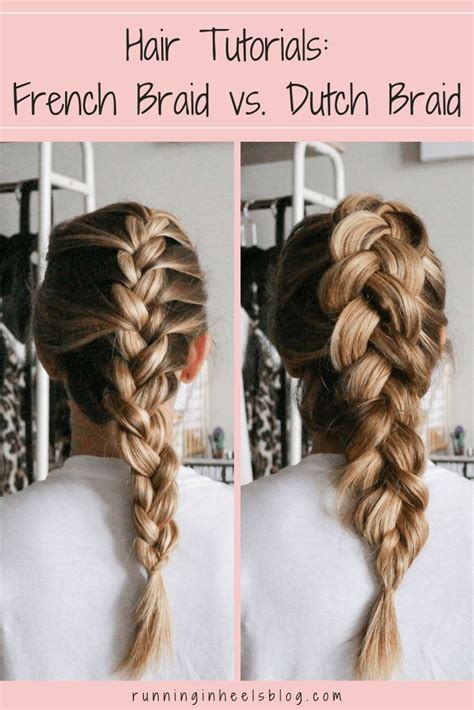Table of Contents
- Introduction
- Dutch Braids vs French Braids: A Comprehensive Comparison
- Types of Dutch and French Braids
- Pros and Cons of Dutch and French Braids
- Choosing the Right Braid for Your Hair
- Step-by-Step Tutorials: Dutch Braid vs French Braid
- Tips and Tricks for Perfect Dutch and French Braids
- Creative Applications for Dutch and French Braids
Introduction
Dutch braids and French braids, the two iconic plaiting techniques, have been adorning heads for centuries. While both create intricate and visually stunning hairstyles, there are subtle differences that set them apart. This comprehensive guide delves into the world of Dutch braids vs French braids, providing a thorough analysis, step-by-step tutorials, and creative inspiration.

Dutch Braids vs French Braids: A Comprehensive Comparison
1. Technique:
- Dutch Braids: Also known as “inside-out” braids, Dutch braids are created by crossing the lower strands over the upper strands, creating a raised, 3D effect that resembles a basketweave.
- French Braids: Conversely, French braids use an “over-under” technique, where the outer strands are crossed over the middle strand, resulting in a flat braid that flows smoothly along the scalp.
2. Appearance:
- Dutch Braids: Their raised, textured appearance gives Dutch braids a bold and объемный look.
- French Braids: The flat, sleek finish of French braids imparts an elegant and sophisticated touch.
3. Hold:
- Dutch Braids: Due to the tight weaving technique, Dutch braids tend to hold better and are less prone to slipping or unraveling.
- French Braids: Their looser construction makes French braids more prone to loosening, especially with fine or slippery hair.
4. Hair Type:
- Dutch Braids: Ideal for all hair types, but particularly suitable for thick and coarse hair that can hold the intricate braids.
- French Braids: More versatile, French braids can be used on various hair types, from fine to thick, and can be adapted to different braid sizes.
Types of Dutch and French Braids
Dutch Braids:
- Classic Dutch Braid: The traditional inside-out braid with a raised, объемный finish.
- Double Dutch Braid: Two Dutch braids created side by side, adding volume and drama.
- Fishtail Dutch Braid: A combination of the Dutch and fishtail techniques, creating a unique, intricate braid.
French Braids:
- Classic French Braid: The standard over-under braid with a flat, flowing finish.
- Inverted French Braid: An inside-out French braid, resulting in a raised braid that appears to be wrapped around the head.
- 4-Strand French Braid: A complex braid that uses four strands of hair, creating a thick and elaborate look.
Pros and Cons of Dutch and French Braids
| Feature | Dutch Braid | French Braid |
|---|---|---|
| Appearance | Raised, объемный | Flat, sleek |
| Hold | Strong | Moderate |
| Hair Type | Thick, coarse | Versatile |
| Complexity | More complex | Less complex |
| Versatility | Limited styles | More versatile |
| Time to Create | Longer | Shorter |
Choosing the Right Braid for Your Hair
Consider the following factors when choosing between a Dutch braid and a French braid:
- Hair Type: Dutch braids are better suited for thick hair, while French braids are more adaptable to various hair types.
- Desired Look: If you prefer a объемный, bold braid, choose a Dutch braid. For a sleek, elegant look, a French braid is a better choice.
- Hold: Dutch braids provide a stronger hold than French braids, making them ideal for activities where hair stability is crucial.
- Skill Level: French braids are generally easier to master than Dutch braids.
Step-by-Step Tutorials: Dutch Braid vs French Braid
Dutch Braid:
- Divide the hair into three sections at the crown.
- Cross the right strand over the middle strand.
- Bring the left strand over the new middle strand.
- Repeat steps 2-3, adding small sections of hair from the sides as you go.
- Continue braiding to the desired length.
French Braid:
- Divide the hair into three sections at the crown.
- Cross the outer right strand over the middle strand.
- Cross the outer left strand over the new middle strand.
- Repeat steps 2-3, picking up small sections of hair from the sides as you go.
- Continue braiding to the desired length.
Tips and Tricks for Perfect Dutch and French Braids
- Brush your hair: Remove any tangles before starting to braid to ensure smooth and even braids.
- Section your hair: Divide the hair into smaller sections to make the braiding process easier.
- Keep the strands tight: Tighten the strands as you braid to create a secure and объемный braid.
- Be consistent: Maintain an even tension throughout the braid to prevent bumps or unevenness.
- Use a hairspray: Spray a light mist of hairspray to hold the braid in place.
Creative Applications for Dutch and French Braids
Dutch Braids:
- Crown Braid: Create a stunning halo by braiding Dutch braids around the head, meeting at the crown.
- Side-Swept Braid: Sweep Dutch braids to one side, adding volume and interest to your hairstyle.
- Updo: Incorporate Dutch braids into an updo, creating a unique and elegant look.
French Braids:
- Half-Up Style: Braid a French braid from the crown to halfway down the head, then let the rest of the hair flow free.
- Romantic Braid: Weave a delicate French braid into a loose, romantic updo.
- **Crown Braid:’ Braid a thick French braid around the head, creating a sophisticated and ornate crown.
Conclusion
Dutch braids and French braids are both versatile and beautiful techniques that enhance the natural beauty of hair. While Dutch braids offer a объемный and bold look, French braids provide a sleek and elegant touch. By understanding the differences, pros, cons, and creative applications of these braids, you can create a wide range of stunning hairstyles that complement your hair type and personal style.
